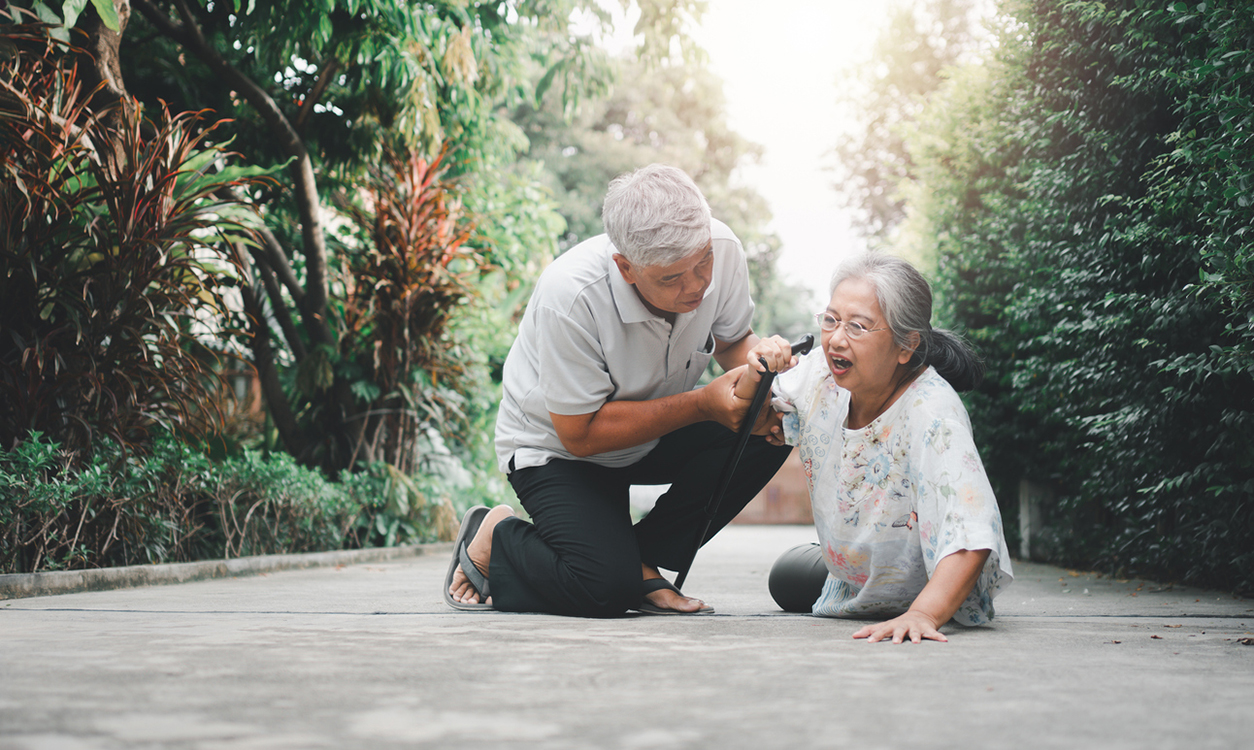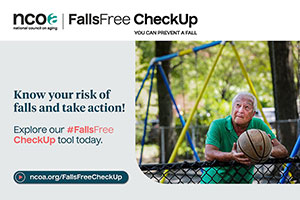How to Prevent Slips, Trips, Stumbles, and Falls

National Falls Prevention Awareness Week 2021 runs September 20–24. We join the nationwide effort to raise awareness that falls are preventable and encourage older adults to remain falls-free and independent by utilizing important tools.
Many people think that for it to qualify as a fall, you need to land on the ground or floor. This is not the case. A “fall” is defined as an event that results in a person coming to rest unintentionally on a lower level, and this could include the ground or floor. You could be getting up from a chair or toilet, lose your balance, and fall backwards. That would be considered a fall. And a fall without an injury is still a fall!
As we age, we lose muscle strength and our reflexes slow down, so strength and balance exercises are important to do each day. And let’s look at the internal and external factors that can cause us to fall:
- Internal factors include decreased hearing, vision impairment, decreased mobility, decreased lower leg strength, incontinence, and medications.
What can you do? Get your hearing and vision checked annually and get a fall risk assessment (try the NCOA’s free Falls Free CheckUp or visit Dr. Milton Curtis’ Senior Fall Prevention Initiative and get a free Senior Safety Score and recommendations). Keep to a regular toileting schedule, review the medications you take with your health care provider or pharmacist, and stay physically active. Recommended exercise is at least 150 minutes of moderate-intensity aerobic or 75 minutes of vigorous aerobic activity, and at least two days of muscle-strengthening activities per week.
- External factors are typically environmental (for example, slippery floors, uneven surfaces, small pets, loose carpet or flooring, poor lighting, and loose footwear).
 What can you do? Keep your environment safe, wipe up spills, watch for any small pets underfoot, repair or replace worn carpet or flooring, use a nightlight, and wear sturdy well-fitted footwear.
What can you do? Keep your environment safe, wipe up spills, watch for any small pets underfoot, repair or replace worn carpet or flooring, use a nightlight, and wear sturdy well-fitted footwear.
There are many evidence-based (proven to be beneficial) fall prevention programs in King County, including A Matter of Balance, Bingocize, EnhanceFitness (locations mapped here), Otago Exercise Program, Stay Active and Independent for Life (SAIL), and Tai Ji Quan: Moving for Better Balance. For information about falls prevention programs in King County, call Community Living Connections (toll-free 844-348-5464).
Other resources include the Washington State Department of Health’s Finding Our Balance Action Plan for Older Adult Falls Prevention. Its goal is to reduce falls-related 911 calls and hospital emergency department admissions and visits. To request the “Finding Our Balance: Prevent Slips, Trips, and Stumbles” falls prevention awareness toolkit, e-mail findingourbalance@doh.wa.gov
We encourage everyone to get involved in supporting healthy aging and falls prevention. If you would like to join the King County Falls Prevention Coalition—a group of professionals, including medical doctors, physical therapists, nurses, pharmacists, and interested community members that meets every other month—e-mail kcfallcoalition@gmail.com.
Take a step today to find the best falls prevention tools for you. You can prevent slips, trips, and stumbles—for yourself and for your loved ones.
 Contributor Mary Pat O’Leary, BSN, RN is a senior planner at Aging and Disability Services. She thanks Lori Clary, the Older Adult Falls Prevention Specialist, and Alan Abe, EMS/Trauma Injury Prevention Specialist, at Washington State Department of Health; staff at the King County Department of Community and Human Services; and everyone involved in offering community-based fall prevention programs for promoting falls prevention awareness.
Contributor Mary Pat O’Leary, BSN, RN is a senior planner at Aging and Disability Services. She thanks Lori Clary, the Older Adult Falls Prevention Specialist, and Alan Abe, EMS/Trauma Injury Prevention Specialist, at Washington State Department of Health; staff at the King County Department of Community and Human Services; and everyone involved in offering community-based fall prevention programs for promoting falls prevention awareness.
This article originally appeared in the September 2021 issue of AgeWise King County.
![Aging & Disability Services for Seattle & King County [logo]](https://www.agingkingcounty.org/wp-content/themes/sads/images/seattle-ads-logo.png)